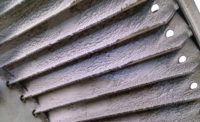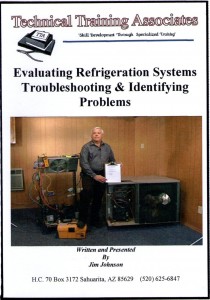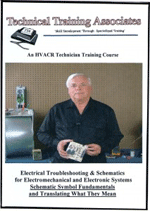Refrigeration compressors need to be properly maintained and require periodic inspection and testing. Unfortunately, the compressor is often ignored until it malfunctions or stops running altogether, at which time it is replaced. Then the system is back up and running - temporarily. Oftentimes the culprit is not the compressor, but a system failure or design problem with accessory equipment that killed the compressor prematurely.
This article describes how to troubleshoot a compressor and the associated problems that can cause a system to fail prematurely. It also discusses the proper methods of diagnosing and repairing system problems.

Suction And Discharge Pressures
Both the suction and discharge pressures at the compressor are normally measured with a standard set of refrigeration gauges. However, this article will explain how to measure pressures on the suction and high side of the system with a digital multimeter (DMM) and pressure module (with specific reference to the Fluke PV350) with or without your standard gauges. If the gauges are left on the system and used in conjunction with this test, the module will verify the accuracy of the standard manifold gauges.To measure the pressures on your DMM in conjunction with the standard manifold gauges, begin by attaching the module hose fitting to the refrigerant service hose on your manifold gauge set, usually the yellow hose.
Attach the module to a DMM and put the module function switch to cm/inches Hg.
Install your blue and red hoses to the suction side and high side of the system as during any normal service process.
To read the suction pressure on your DMM, open the blue handle on the manifold. This puts the system suction pressure into the module. Read the pressure on the digital readout and compare it to the gauge pressures. Do not be alarmed if the pressures don't match exactly. The module referenced in this article is typically much more accurate than a standard set of refrigeration gauges.
To read the discharge pressure on your DMM, close the blue valve on your gauges and open the red handle on the manifold. This puts the system discharge pressure into the module.
To remove the module, simply reverse the process you followed when installing the unit. Caution: Be sure to close the high-side port of your gauges first, and remember to remove the refrigerant from the high-side gauge by allowing the compressor to run and pull excess refrigerant into the low side of the system.
To measure the pressures on your DMM and module without installing your manifold gauges, use the following procedure:
To remove the module, simply reverse the process you followed when installing the unit. Caution: Be careful when removing the high-side port of your gauges, as it can be under very high pressure. To minimize refrigerant loss, learn to practice safe refrigerant handling habits when removing the module from the high side of the system. This includes using low loss gauge hoses and shutting off the compressor before gauge removal. This allows the pressure to equalize in the system, which will reduce the discharge pressure. When removing the gauge from the low side of the system, it is not necessary to shut down the compressor first, but always remember to shut off the service valve at the compressor before removing the service hose.
Discharge Line Temperature
Pressure and temperature are fundamental tests that you can perform to determine what is happening inside the compressor.To measure the temperature of the compressor, you can use a pipe clamp accessory (such as the 80PK-8 from Fluke) with a DMM to measure the discharge line temperature at the discharge of the compressor.
High temperatures above 275 degrees to 300 degrees F will slowly destroy lubricant qualities and performance of the compressor. These high temperature conditions can be caused by high condensing temperatures/
pressures, insufficient refrigerant charge, noncondensible gas within the system, high superheat from the evaporator, restricted suction line filters, and low suction pressure.
These conditions cause the compressor to have a higher than normal compression ratio, work harder, and generate hotter internal hermetic motor windings. As a result, they can cause premature compressor wear, fatigue, and failure.
Temperature Survey
A temperature survey is a critical part of the technician's job. A quick check of a system's components not only helps to diagnose troubles but also allows you to anticipate failures by regular monitoring of critical temperatures. Use an infrared thermometer to do a quick survey of:
With an infrared thermometer, you can survey a refrigeration system by scanning the temperatures of various components. While touching each of the components often does this, a noncontact infrared probe is faster.
By keeping careful records, it is possible to detect trends that indicate impending failure. This allows you to keep the system in top condition and avoid costly failure.
Infrared instruments read best when measuring an object with a dull surface. If the surface is shiny, dull it with black markers, non-gloss paint, masking tape, or electrical tape.

Recording Temperatures
To check refrigeration system performance, it is often useful to record temperature in the refrigerated space. This allows you to detect problems that may go unnoticed with a single system check.For instance, in a refrigerated space it is important to ensure that temperature variations are minimized. Temperature variations may result from changes in load or ambient conditions that occur over periods of time, so constant monitoring is called for. By recording minimum and maximum temperatures in key locations over a period of time, you can be sure that air circulation and refrigeration capacity meet the application requirements.
Digital recording thermometers allow you to record minimum and maximum temperatures over extended periods of time.
Some recording thermometers (such as the Fluke 54) are temperature data loggers, which means they will record data temperatures at a predetermined rate over a specified time frame. These are especially useful when minimum, maximum, and average temperatures are required to service the unit over a longer time frame.
Compressor Valve Performance Test
To test small hermetic and semi-hermetic compressors used for medium and low temperature applications, the following method can be used to test for internal valve leakage.Attach the pressure module to a DMM and put the module function switch to cm/inches Hg.
The compressor should have pulled down to at least 15 inches of Hg. If the vacuum reading starts weakening toward 10 inches of Hg vacuum, the discharge valves of the compressor may be leaking and will probably need to be replaced. If the compressor does not pull a vacuum below 15 inches Hg, the suction valves are weakening and may need to be replaced. If the compressor is welded or hermetically sealed and these conditions exist, a new compressor is the only possible remedy. If the compressor is a semi-hermetic type, the compressor valves can be replaced.
Caution: Whenever replacing a compressor that has faulty valves, be sure to diagnose the complete refrigeration system before and after a new compressor is installed to avoid repeated compressor failures.

Compressor Electrical Motor Faults
A clamp meter (such as Fluke Model 322) is designed to measure both AC voltage and AC current. An advantage of such a meter is a built-in current clamp. This allows current to be measured without breaking into the electrical circuit. A compressor failure is often caused by an electrical fault. To check the compressor for electrical problems, remove the electrical terminal cover and check the following external connections:Caution: When performing electrical measurements on compressors with internal thermal motor protection devices that have been running extremely hot, be sure to give the compressor time to cool down prior to the electrical test. This will allow the device to reset to its normal position.
Refrigeration System Problems
Occasionally defective compressors with electrical winding failures are diagnosed by a technician as being caused by an electrical system problem. However, mechanical system failure or inferior installation and service practices often cause compressor electrical problems. These problems include:Here are some simple procedures to diagnose refrigeration problems.
Compressor bearings: These bearings can fail or lock up due to poor piping practices, which cause oil clogging in the system and result in insufficient oil return to the compressor. If the bearings do not lock up and continue to wear during these conditions, the rotor will lower into the stator housing, shorting out the windings. To diagnose this problem, measure the compressor amps. They should not exceed the manufacturer's full load ratings. Worn bearings will cause higher than normal amps.
Inspect the oil level via the compressor sight glass. If there is no sight glass, use an infrared thermometer to measure the sump of the compressor housing. The oil level can be detected with the temperature probe. The sump temperature will be different on the compressor housing at the oil level.
Caution: Whenever an oil problem exists due to poor piping practices, the correct remedy is to fix the piping problem, not to continue to add more oil to the system. Also, remember that undercharged units will sometimes trap the oil in the evaporator. Thus, it is necessary to add refrigerant to move the oil out of the evaporator and back to the compressor.
High discharge temperatures: High head pressures or high superheat causes this problem. The compressor discharge line can be measured quickly using an infrared thermometer on a dull section of pipe. Measure the discharge pressure using a pressure module. Convert the refrigerant discharge pressure to determine condensing temperature and compare it to the ambient air temperature. If there is a temperature difference greater than 20 degrees to 30 degrees, there is either noncondensible gas in the system or restricted airflow across the condenser.
Note: Temperature differences will vary due to original manufacturer's design and efficiencies.
Insufficient airflow: Check for airflow across the evaporator using a digital thermometer. Place a bead thermocouple (like the Fluke 80PK-1) on the discharge side of the coil and on the return side of the coil. Record the temperature difference on the air conditioning unit. Expect a temperature difference of about 18 degrees to 22 degrees. On refrigeration units, expect about 10 degrees to 15 degrees temperature difference.
Note: Temperature differences may vary depending upon initial design and humidity requirements of the storage environment.
Low suction pressure: Extremely low suction pressures can be checked using the pressure module and your DMM. Install it at the compressor and record your suction pressure. Convert the refrigerant pressure to temperature using a pressure-temperature (PT) chart.
Measure the return air temperature before the evaporator. Compare the refrigerant temperature to the desired evaporator return air temperature. On air conditioning units, expect about 35 degrees to 40 degrees temperature difference; on refrigeration units, expect about 10 degrees to 20 degrees temperature difference.
Liquid refrigerant flooding back: Check for liquid refrigerant flooding back to the compressor by determining the superheat using the pressure module and the pipe clamp along with the DMM. Check suction pressure and convert the refrigerant pressure to temperature using the PT chart. Measure the suction line pipe temperature. Compare the difference of the two temperatures. If there is no temperature difference, then you are bringing back liquid to the compressor. If there is a temperature difference between 10 degrees and 20 degrees, then you have normal superheat and you are not slugging the compressor with unwanted liquid.
Jourdan is program director of Environmental Systems & Refrigeration Technology at Wenatchee Valley College (Wenatchee, Wash.). He prepared this article in conjunction with Fluke Corp. For more information, contact the author at gjourdan@wvc.edu or visit www.fluke.com.
Publication date: 04/05/2004







